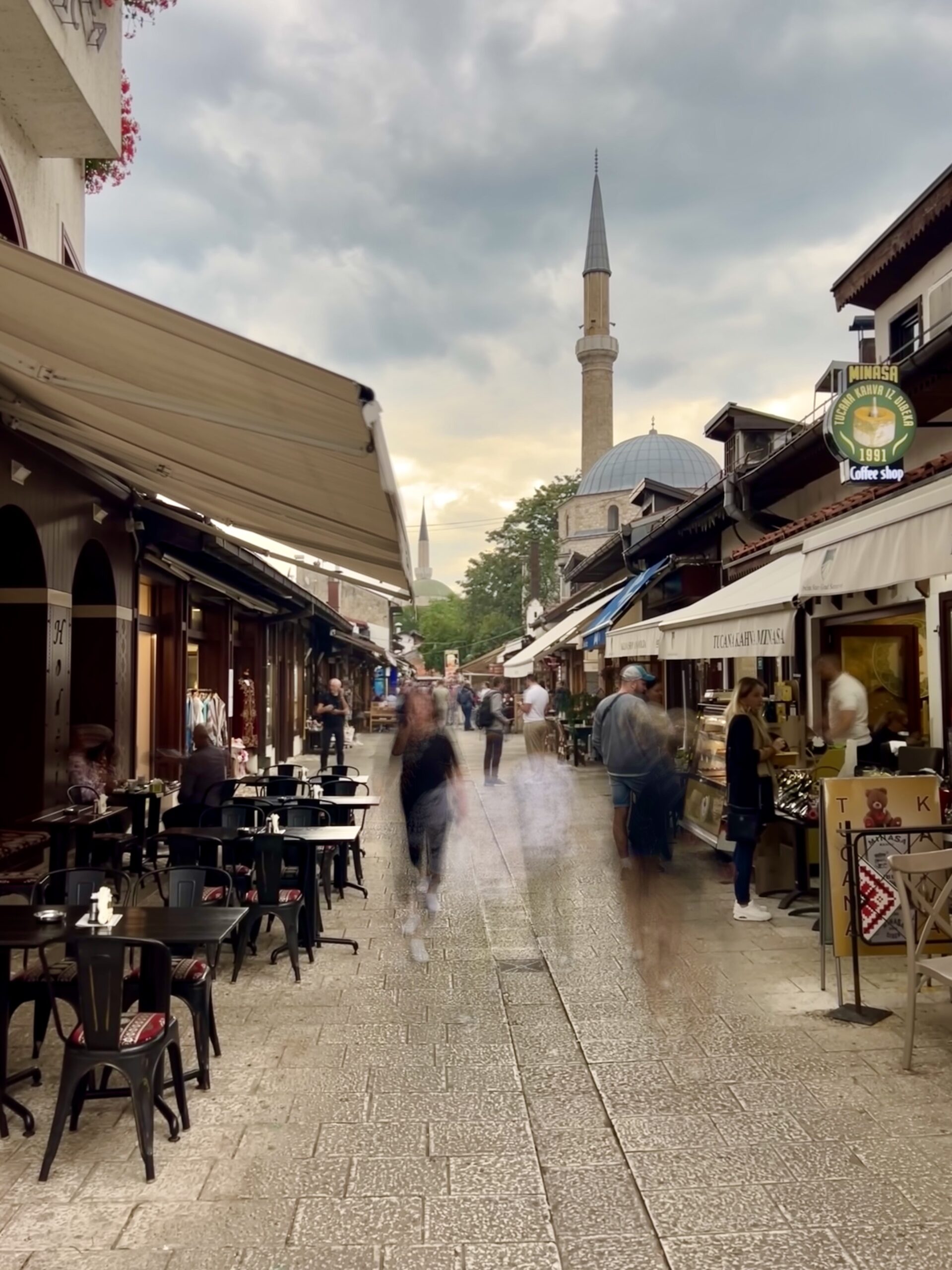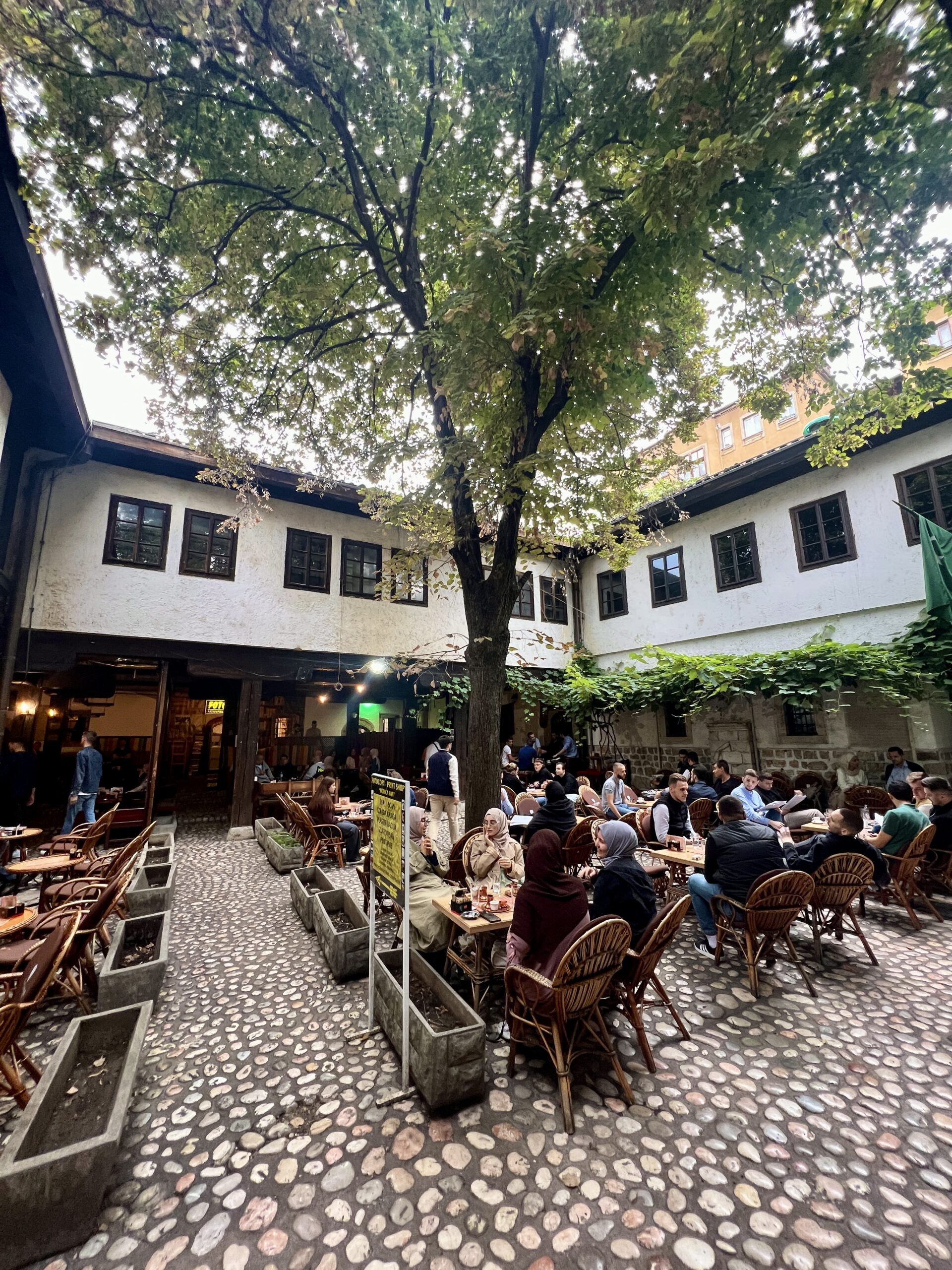Visiting Sarajevo, the Jerusalem of Europe. Part I
Visiting Sarajevo travel guide: history, Old Town, mosques and museums—what to see, where to eat, and tips for first-timers.
Contents
Stage 4: Journey through the Balkans.
Arriving in Sarajevo
We arrived in Sarajevo after an overnight bus journey from Belgrade. The bus departed at 10 in the night, and we reached Sarajevo very early in the morning. Our first stop was for breakfast and some work in a cosy café (Kawa Cafe) with reliable Wi-Fi, while we waited to check into our hostel. Fortunately, our accommodation was conveniently located next to Pigeon Square, making it the perfect base for exploring Sarajevo.
Getting Around Sarajevo
Sarajevo offers an efficient tram system that’s also budget-friendly. You can purchase tram tickets directly from the driver for 1.80 Bosnian Convertible Marks (approximately 0.90 EUR or 1.00 USD). Fun fact: Sarajevo was the first city in the Balkans and Central Europe to have an electric tram, and it served as the testing line for the tram system in Vienna and the Austro-Hungarian Empire.
On our way from the bus station to the city centre, we had the chance to see the Vječna Vatra, also known as The Eternal Flame, which serves as a memorial for World War II. Right next to it, there was another reminder of Marshal Tito, the former leader of the ex-Yugoslavian state.

Exploring Sarajevo’s Historical Sights
Firstly, as always, we sign up for a free walking tour. It gave us a first impression of this historical city and provided insights into what we could explore later.
Sarajevo Free Walking Tour
Our walk began at the Latin Bridge, the site of Archduke Franz Ferdinand’s assassination in 1914. This event, which took place in a nearby small street, triggered World War I and shaped the course of the 20th century. The assassination of Franz Ferdinand, the heir to the Austro-Hungarian Empire, by a Serbian nationalist, ultimately led to Austria-Hungary’s declaration of war on Serbia. In response, Russia declared war on Austria-Hungary to defend Serbia, and subsequently, Germany declared war on Russia as an ally of Austria-Hungary. These events unfolded rapidly in 1914, with Germany declaring war on Russia’s ally, France. Germany’s invasion of Belgium and Luxembourg also drew Britain into the conflict. The Ottoman Empire and Bulgaria eventually joined the Central Powers, which included Germany, Austria-Hungary, and the Ottoman Empire. These early actions set the stage for future conflicts, including World War II.

After this quick History lesson, we headed to the City Hall, a magnificent building inspired by Andalusian and Islamic art. An interesting historical fact: before the City Hall was built, a wealthy individual owned a house on the same site. The owner agreed to sell the land only if the house was moved stone by stone to the opposite side of the river. Today, this house still stands, famously known as the House of Spite (Inat Kuća), an Ottoman-era house that now hosts one of the city’s finest restaurants, specialising in Bosnian cuisine. You can easily spot that the main balcony of the house now faces the opposite side of the river.

The Old Town: Baščaršija
Sarajevo is a relatively new city, founded after the Ottoman conquest. Built in the 15th century, it was once home to craftsmen and their shops, each street was dedicated to a different trade. Nowadays, these artisan shops have transformed into souvenir stores and cafes. Baščaršija also features the iconic Pigeon Square and the Sebilj fountain, an example of Ottoman-style wooden architecture. This fountain is one of Sarajevo’s most recognizable landmarks, and local stories claim that drinking from it ensures your return to the city. You’ll always find the fountain surrounded by pigeons, hence the name of the square.

Sarajevo’s Religious Diversity
Now, let’s explore the part of the tour where we see how four religions have lived together in this city for centuries. Sarajevo’s history is defined by the peaceful coexistence of four major religions: Islam, Judaism, Catholicism, and Orthodoxy.
Gazi Husrev-beg Mosque:
This historic mosque, constructed in the 16th century, stands as one of the most representative Ottoman structures in the Balkans. Its resilience through wars and fires reflects the city’s enduring spirit.
Museum of the Jews of Bosnia and Herzegovina:
Originally a synagogue, this building, known as the Old Synagogue, dates back to the mid-16th century. It reflects the presence of Jews in Bosnia and Herzegovina. The roots of the Jewish community here can be traced back to the Ottoman Empire’s rule in the region, with Sephardic Jews settling in the area following their expulsion from Spain in 1492.

“Where East Meets West”
As we walk west from the Mosque, we cross the line that reads “Where East Meets West” a phrase frequently used to define Sarajevo’s unique cultural blend. Engraved on the floor, this phrase describes Sarajevo’s fusion of cultures, spanning from Ottoman architectural influences to Austro-Hungarian influences.
Sacred Heart Cathedral: Completed in 1889, this Catholic cathedral serves as a testament to the city’s multicultural heritage.
Orthodox Cathedral Church of the Nativity of the Theotokos: Situated nearby, this church was constructed during the Austro-Hungarian occupation and functions as the primary place of worship for the Serbian Orthodox community in Sarajevo.

In just a few metres’ distance, we can observe how these four religious/communities —Muslims, Jews, Catholics, and Orthodox Christians—have peacefully coexisted in Sarajevo over the centuries, making the city one of the most multicultural in Europe.
Hidden gems in Sarajevo
Our walk through Sarajevo also led us to a historical landmarks like the Tašlihan, which dates back to the 16th century. The Tašlihan provided accommodation, food, and shelter for travellers and merchants along trade routes that passed through Sarajevo during the Ottoman period.

Finally, we visited the Old Jewish cemetery, which reflects the city’s diverse past. Sadly, the Jewish cemetery served as an artillery position during the Bosnian and Herzegovina war. (But I will talk more extensively about that period in my next post on this trip).
We concluded our first day at Cafe Tito, adjacent to the Bosnia and Herzegovina National Museum. Here you can find a collection of items from the Yugoslavia period. Similar to Serbia, this country also appears to have some nostalgia for Tito’s era.

Must-Try Bosnian Food
- Inat kuća: Located inside the Ottoman house moved to build the City Hall, this restaurant offers a unique atmosphere and delicious Bosnian cuisine. Try the sogan dolma (stuffed onions with meat) as a starter.
- Ćevabdžinica Željo and Ćevabdžinica Petica Ferhatović: These local restaurants are known for their Cevapi, a traditional Bosnian dish.
- Cafe Divan: For a relaxing post-meal coffee or tea, visit this traditional café with an a relaxing interior patio and unique atmosphere.
- Trgovke Street: If you’re up for drinks and shisha after dinner, explore this hidden alley leading to a square with many cafes.

Conclusion
Our first day visiting Sarajevo offered us a understanding of the city’s history and multiculturalism. In our next post, we’ll talk into more recent history of Bosnia and Herzegovina, including the Siege of Sarajevo from 1992 to 1996. Stay tuned for more insights into this remarkable city, often referred to as the “small Jerusalem” or a miniature Istanbul.
There are a few more places to visit in the city: Kovači Cemetery, Trebević mountain, and the Yellow Fortress. But I will discuss them in my next post about the recent history of Sarajevo. So far, I’ve been pleasantly surprised by this city. While I’ve heard its name in the news many times, I couldn’t believe how incredible and multicultural it is. It’s often referred to as the “small Jerusalem,” but it reminds me more of a small Istanbul.








